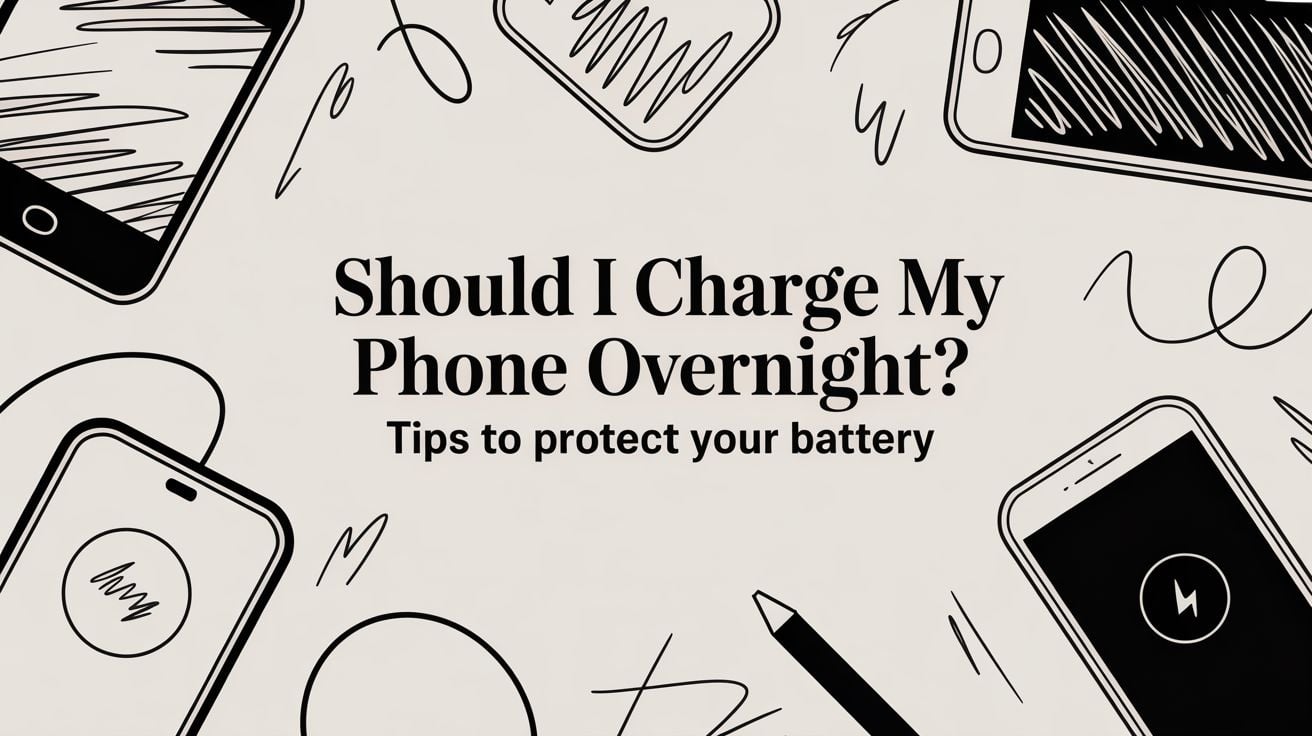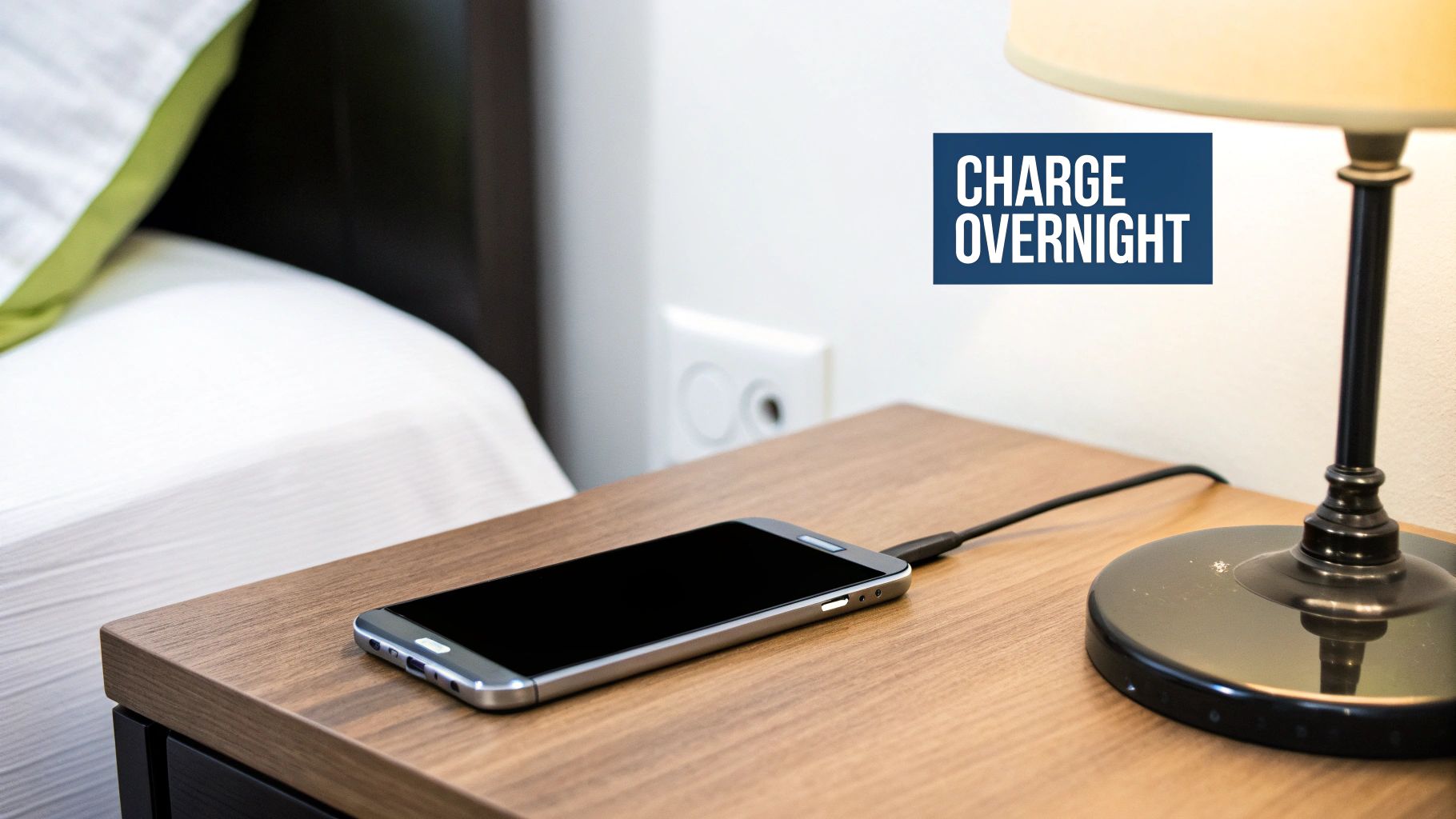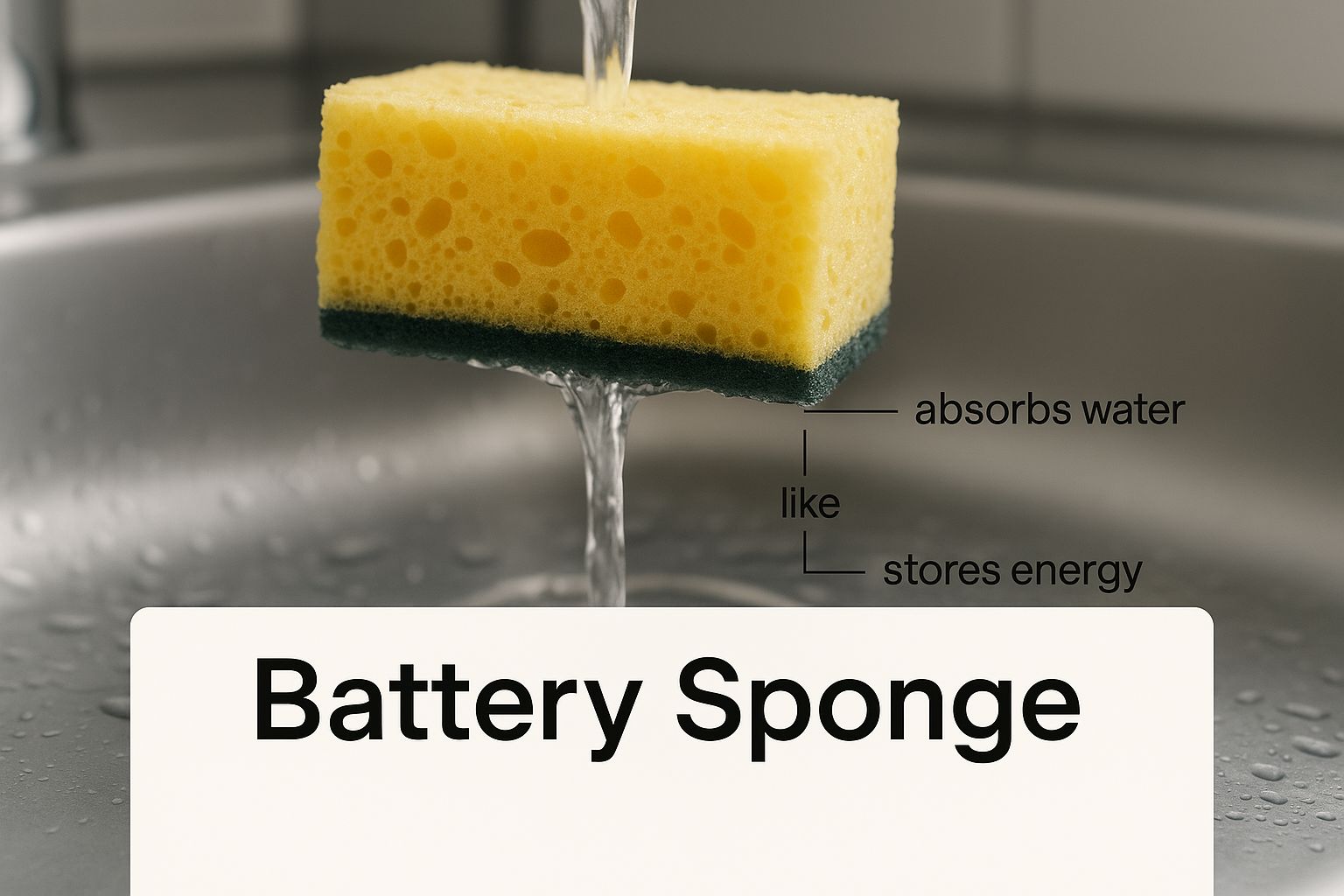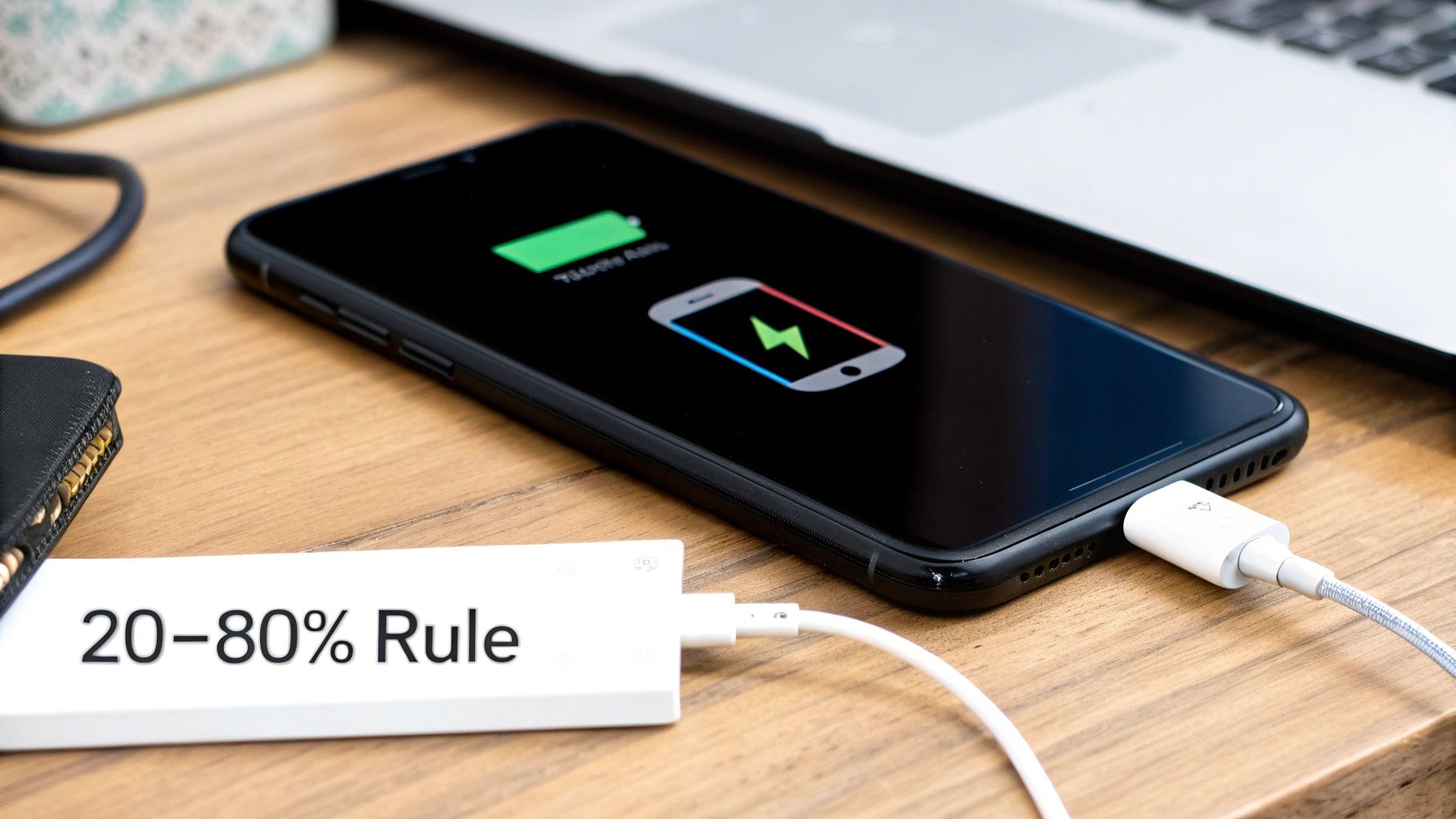
Should I Charge My Phone Overnight? Tips to Protect Your Battery
So, is it safe to charge your phone overnight? The short answer is yes, it’s generally safe, but it’s not the best thing for your battery’s long-term health. Modern smartphones are smart enough to stop charging when they’re full, so you don’t have to worry about immediate danger.
Understanding the Overnight Charging Debate
Plugging in your phone before bed is a habit for most of us. You wake up, and you have a full battery ready for the day. While the old fear of a phone “overcharging” and causing a fire is mostly a myth now, the real concern is about keeping your battery healthy for a long time.

The real issue isn’t about one night of charging; it’s what happens when you do it every single night. Think of your phone’s battery like a muscle. Keeping it at 100% charge for hours is like holding a muscle in a tight fist all night. It won’t break, but it does cause a lot of unnecessary, long-term strain.
Why a Full Charge Isn’t Always the Goal
The batteries in our phones are happiest when they’re not pushed to their limits. In fact, they wear out much faster when they’re always kept above 80% or allowed to drop below 20%. This is why you’ll hear experts say you should try to keep your phone’s charge somewhere in that happy middle ground. You can find a great breakdown of how overnight charging can be ruinous for your phone’s battery on Wamsinc.com.
This is where “smarter charging” comes in. It’s not about avoiding danger, but about making your battery last as long as possible. By making a few small changes, you can slow down how fast your battery gets old.
The goal is simple: reduce the time your battery spends sitting at 100%. The less time it’s held at this high-stress level, the healthier it will stay over the years.
What Really Affects Battery Health?
A few key things decide how quickly your battery wears out. Understanding them is the first step to building better habits:
- Charge Cycles: Every time you use up 100% of your battery’s power, it counts as one “cycle.” By keeping your phone between 20% and 80%, you’re not completing as many full cycles, which slows down the wear.
- Heat: Heat is the number one enemy of batteries. Charging makes your phone warm, and doing it overnight—especially if your phone is under a pillow—can create too much heat that damages the battery over time.
- Stress from Being Full: As we said, keeping a battery at 100% puts it under a lot of stress. This is one of the main reasons it loses its ability to hold a full charge over time.
To make this easier, here’s a quick summary of what you need to know about leaving your phone plugged in all night.
Overnight Charging At a Glance
| Common Concern | Modern Reality | Smarter Practice |
|---|---|---|
| Overcharging & Fire Risk | Modern phones have built-in safety features to stop charging at 100%, making this very rare. | Use good quality chargers and cables, and don’t charge your phone under pillows to avoid heat. |
| Battery “Memory” | A myth from old types of batteries. Modern batteries don’t have this problem. | Don’t worry about “training” your battery. Just try to avoid very high or very low charge levels. |
| Long-Term Damage | This is the real issue. Keeping a battery at 100% for hours every night causes long-term stress and aging. | Try to keep your battery between 20% and 80%. Use tools that can limit the charge level overnight. |
The key takeaway is that while modern phones are safe, our nightly habits are still making our batteries get old faster than they need to.
To figure out if you should be charging your phone overnight, you first have to understand what’s actually happening inside your phone.
Let’s forget the technical terms for a second. Think of your phone’s battery like a simple kitchen sponge. When you plug it in, it’s like the sponge soaking up water. When you’re using your phone, you’re squeezing that water back out.
Simple enough, right? But here’s the catch: that sponge can only be soaked and squeezed so many times before it starts to get worn out and can’t hold as much water as it used to. This is what we call a charge cycle.
A full charge cycle is when you’ve used up 100% of your battery’s power. That doesn’t have to happen all at once. You might use 70% today and 30% tomorrow—that’s one full cycle. Every single cycle wears the battery down just a tiny bit, permanently reducing how much of a charge it can hold.
This infographic gives a great visual of the sponge idea, soaking up and releasing energy.

And just like a real sponge, your battery is under the most strain when it’s either bone dry or completely full.
Your Battery’s Two Biggest Enemies
There are two main things that cause this “sponge” to wear out faster than it should, and unfortunately, overnight charging creates the perfect conditions for both.
- Extreme Charge Levels: Keeping your battery at 100% for hours is like leaving a sponge completely soaked and under constant pressure. On the other hand, letting it die and sit at 0% is like letting it dry out until it gets stiff. Both of these extremes put a lot of stress on the battery’s insides.
- Too Much Heat: Heat is the absolute number one killer of batteries. Charging makes your phone a bit warm, which is normal. But when your phone is plugged in all night—especially if it’s trapped under a pillow or in a thick case—that heat has nowhere to go. This constant warmth speeds up the damage to your battery.
This is exactly why you’ll hear experts recommend keeping your battery in the “sweet spot” of 20% to 80%. Staying in this range is the single best thing you can do to reduce stress and slow down the aging process, helping your battery last for years, not months.
By avoiding these two killers, you’re not just saving your battery’s power; you’re making sure your phone stays fast and reliable for a long time. It’s also worth understanding how slow charging is essential for your smartphone’s battery health, as it helps with the heat problem. Managing these things is the real secret to a happier, healthier device.
Meet Your Phone’s Built-In Battery Guardian
Thankfully, you’re not on your own in trying to keep your battery healthy. Phone makers know that most of us charge our phones overnight, so they’ve built some clever software to act as a silent protector for your battery.
These features are designed to solve the exact problem we’ve been talking about: the stress of sitting at a 100% charge for hours. Instead of just filling the battery to the top and keeping it there, your phone now learns from your habits to charge in a smarter way. It’s a real game-changer for anyone who plugs in their device before bed.
How Smart Charging Works
Modern smartphones use smart technology to learn your daily routine. The software pays attention to when you usually wake up and unplug your phone. With this information, it changes the charging pattern to reduce strain while still making sure you wake up to a full battery.
For example, Apple’s Optimized Battery Charging is a great example of this. When you turn it on, your iPhone will charge quickly to 80% and then just… pause. It holds the charge at that healthier level for most of the night. Then, it figures out the perfect time to restart, finishing that last 20% just before you normally wake up. Android phones have a similar feature, often called Adaptive Charging, which does the same smart trick.
This smart approach means that instead of spending eight hours under high stress at 100%, your battery might only spend 30 minutes there. It’s a small change, but it greatly reduces wear and tear over time.
Your phone actively works to protect its own battery by learning your habits and delaying the final charge until it’s actually needed. This makes the question less about “Should I charge my phone overnight?” and more about “How can I best support this smart feature?”
In short, these features understand that overnight charging is a common habit and work to make it less harmful. Unlike old fears, systems like Optimized Battery Charging use power from the wall to keep the phone running once it’s full, giving the battery a chance to rest. You can read more about how Apple’s smart charging protects your battery during these long charging sessions.
The Real Cost of Keeping Your Phone Plugged In
Does charging your phone overnight make your electricity bill shoot up? It’s a common worry, but the good news is, the cost is surprisingly tiny. You’re probably spending less than a dollar a year to keep your phone charged.
The real cost isn’t on your utility bill; it’s about the bigger picture. When billions of us leave our phones plugged in all night, every night, that tiny bit of energy adds up to a massive amount of electricity used worldwide.
A standard smartphone charger only uses about 2 to 5 watts while it’s actively charging your phone. If you do the math for a full year of daily charging, it comes out to a very small amount of electricity for one person. If you want to dive deeper into the numbers, there are some great insights about device energy use over on nextbusinessenergy.com.au.
The Hidden Environmental Cost
Forget the electricity for a second. There’s a much bigger problem: e-waste. The constant stress from being plugged in for hours, night after night, slowly wears down your battery’s health. As it gets weaker, you find yourself needing a new phone much sooner than you should.
Each phone that gets replaced too early just adds to the growing mountain of electronic waste. By adopting healthier charging habits, you’re not just making your phone last longer—you’re also helping to reduce a huge environmental problem.
This is where smart charging really starts to make sense. By taking care of your battery, you reduce the need for brand-new devices and all the materials it takes to build them. It’s a simple change that has a real, positive impact, one charge at a time. The whole idea is to keep your phone running well for as long as possible—a win for your wallet and the planet.
Simple Habits for a Healthier Phone Battery
Knowing how batteries work is one thing, but actually putting that knowledge into practice is what saves your phone from an early death. It’s not about complicated rules; a few simple, daily habits can make a huge difference, keeping your phone running smoothly for years, not just months. These small actions are your best defense against the two biggest battery killers: heat and stress from being too full.

The goal is to keep your battery in its happy place. By simply avoiding the extreme ends of the charging range—fully charged or completely dead—you reduce the stress that makes it get old too fast. Honestly, this is far more important than worrying about whether you should charge your phone overnight without a plan.
The 20-80% Rule
If you only adopt one new habit, make it this one: try to keep your battery’s charge level between 20% and 80%. Think of this as the “green zone” for your battery’s long-term health. Constantly filling it to 100% or letting it die completely is what causes the most wear and tear over time.
Here’s how to stay in that sweet spot without much effort:
- Small Charges Are Your Friend: You don’t have to wait until your battery is almost dead. Plugging it in for short periods throughout the day is much healthier than one long, stressful charge overnight.
- Avoid Extreme Temperatures: This is a big one. Never charge your phone in direct sunlight, inside a hot car, or under your pillow. Heat is a battery’s worst enemy, and charging already creates its own warmth.
- Use Good Quality Chargers: Stick with the charger that came with your phone or one from a trusted brand. Cheap chargers can provide uneven power, which can slowly damage your battery.
Beyond just the overnight debate, other things matter too. For example, have you ever wondered if you should you let your iPhone battery drain completely? The answer might surprise you, but it all comes back to avoiding those stressful extremes.
Quick Do’s and Don’ts
To make things even simpler, here’s a quick reference guide. These are the main habits that will help you get the most out of your battery life.
Battery Charging Do’s and Don’ts
| Do | Don’t |
|---|---|
| Keep the charge between 20% and 80% | Charge to 100% or let it die completely |
| Use short, small charges | Leave it plugged in for long periods at full charge |
| Use good quality, certified chargers | Use cheap, uncertified chargers and cables |
| Keep the phone cool while charging | Charge it in hot places like a car or in direct sun |
For a deeper dive into this, check out our complete guide with more tips to maintain your phone’s battery health.
The Takeaway: It’s the small, consistent habits that add up. Taking care of your battery by avoiding too much heat and extreme charge levels is the secret to keeping it healthy and getting the most out of your device for years to come.
Got Questions? We’ve Got Answers.
Even after learning about batteries, a few common questions always seem to pop up. Let’s answer them directly so you can charge your phone with confidence.
Does Fast Charging Ruin My Battery?
Fast charging is a great feature, but it has a downside. Pushing power into your battery so quickly creates a lot more heat, and heat is bad for battery health. Think of it like drinking a glass of water—sipping it slowly is easy, but chugging it is a shock to your system.
Using a fast charger when you’re in a hurry is perfectly fine. But using it all the time, especially when you charge your phone overnight, can shorten your battery’s life. For your regular, daily charging when you have more time, using a standard, slower charger is a much better choice.
Is It Safe to Use My Phone While It Charges?
For the most part, yes. Sending a text or browsing a website while plugged in won’t cause any problems. The trouble starts when you do something that uses a lot of power, like playing a demanding game or streaming a high-quality movie.
That’s when the heat really builds up—you’ve got heat from charging plus heat from the phone working hard. This double dose of heat puts a lot of stress on the battery. If your phone ever feels very hot in your hand, that’s its way of telling you to give it a break until it cools down.
Key Takeaway: If there’s one villain in this story, it’s heat. Whether it’s from fast charging, heavy gaming, or just leaving your phone in a hot car, too much heat is what makes your battery get old too fast. Keeping your phone cool is the most important thing.
Should I Let My Battery Drain to 0%?
This is a classic myth from the days of old batteries that had a “memory effect.” For the modern batteries in every smartphone today, letting it die completely is actually one of the worst things you can do.
Regularly running your battery down to zero puts a lot of strain on it and will definitely shorten its lifespan. It’s far healthier to plug it in when it gets down to around 20%. And if you’re curious about the other end of the scale, you can learn more about when you should let your phone battery charge to 100% in our other guide.
Is Wireless Charging Less Efficient?
Yes, it is. Wireless charging seems like magic, but it’s not perfect. The process of sending power through the air creates more waste heat and is almost always slower than just using a good cable.
The convenience is fantastic, no one can deny that. But if you’re using a wireless charger all the time, especially in a warm room, you might be helping your battery age faster without realizing it. It’s a classic trade-off: convenience now versus a longer battery life later.
Ready to stop worrying and take complete control of your charging? With Chargie, you can. This little smart device lets you set automatic charging limits, making sure your battery stays in that happy 20-80% zone and never overcharges overnight. Extend your phone’s life and protect your investment by visiting https://chargie.org.

